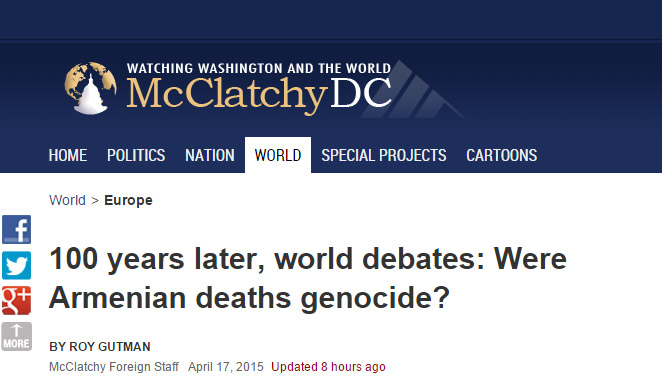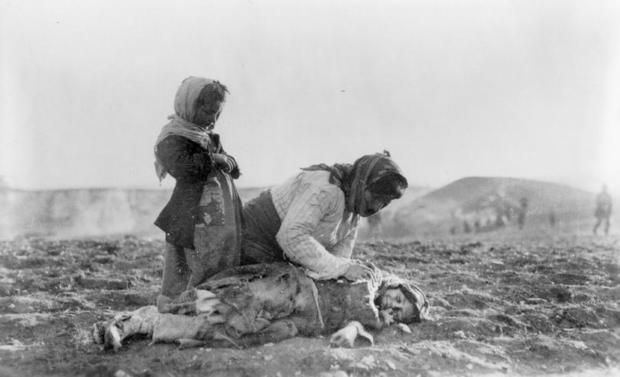
McClatchyDC: 100 years later, world debates: Were Armenian deaths genocide?
7 min readSource: http://www.mcclatchydc.com/2015/04/17/263584/100-years-later-world-debates.html
YEREVAN, ARMENIA — In the swank shops and tidy cafés that line the new pedestrian zone in Armenia’s capital, there’s barely a hint that nearly everyone here is the descendent of a generation that escaped with their lives in a harrowing flight from Ottoman Turkey in the midst of World War I.
On the eve of the centennial commemoration of what Armenians call Meds Yeghern, or “the great calamity,” posters featuring a violet forget-me-not and a slogan, “We remember and we demand,” dot Yerevan.
The symbol hasn’t caught on, even in government offices.
Yet Armenia, and the slaughter, is at the center of world attention as the April 24 anniversary nears.
French tenor Charles Aznavour, widely hailed as France’s Sinatra, both of whose parents were of Armenian descent, will be here, as will French President Francois Hollande and Russian President Vladimir Putin. Pope Francis, who many had hoped would attend, sent a message assuring his “closeness” when the Armenian Apostolic Church on April 23 canonizes as a group the “martyrs” of 1915. Thousands of members of the Armenian diaspora are expected to travel here; Kim Kardashian, arguably the most famous of American Armenians, already has come and gone, with her husband, Kanye West.
It’s a heady time for this small, landlocked state in the south Caucasus, one of the nations that emerged from the collapse of the Soviet Union a generation ago and yet remains largely isolated.
Even the event for which it’s best remembered, the “immense and senseless slaughter” that’s “widely considered the first genocide of the 20th century,” in the recent words of Pope Francis, remains controversial, its details contested, its origins and causes angrily debated.
The pontiff’s words at a papal Mass in the Armenian rite to commemorate the centennial of the atrocities, and his admonition to modern-day Turkey not to deny the “evil,” provoked a sharp response from Ankara, which recalled its ambassador from the Vatican.
Turkish President Recep Tayyip Erdogan dismissed the pope’s statement as “nonsense.” He pointed out that historians have yet to reach a conclusion on what took place. “I would like to warn the honorable pope not to make such a mistake again,” he said.
Such talk from Turkey has for years prevented broad acceptance that what happened in 1915 was genocide. Only 20 countries have accepted that definition for the Armenian events, and they don’t include the U.S., Britain, Germany or Israel, though the tide may be turning: The European Parliament approved a resolution recognizing genocide a few days ago, but U.N. Secretary-General Ban Ki-moon recently called the 1915 events “an atrocity crime.”
Leaders of Armenia see the pope’s statement as a major victory. “Calling things by their rightful name cannot but have a strong impact,” said President Serzh Sargsyan. Added Foreign Minister Edward Nalbandian, the pontiff’s words “show that Turkey and the international community are talking in different languages.”
Lost in the noise was the pope’s call for Armenia and Turkey to take up the path of reconciliation again. “Despite conflicts and tensions, Armenians and Turks have lived long periods of peaceful coexistence in the past, and even in the midst of violence, they have experienced times of solidarity and mutual help,” he said.
Reconciliation seems unlikely in the short term, however, not least because both nations have been unable to come to a common understanding of what happened when Armenians were forcibly relocated from what’s now Turkey during World War I. Indisputably, hundreds of thousands died. Armenians claim that’s what the Ottoman Empire intended. Turkey says that’s not clear and that in any case Armenians bear some of the blame.
In Armenia, nearly every family was affected by the deportations, and many are convinced that the killings and deaths were premeditated.
At the ultra-modern hilltop campus of the American University of Armenia, which is affiliated with the University of California, most students in a course on genocide defended the government drive for international genocide recognition.
“The genocide issue is what unites all Armenians in the world,” said Areg Badalyan, 23, one of whose grandfathers was from Mus, in eastern Turkey. He said Turkish recognition of Armenian genocide should be the country’s first priority.
Marianna Javakhyan, 22, whose great-grandfather fled Kharpert, now known as Elazig, agreed that demanding genocide recognition was “very important for our national identity, for keeping the whole nation together, for one’s dignity.”
Still, in underdeveloped Armenia, there are those who suggest the country should move on. “If we did not have the recognition of genocide as a priority for foreign policy, maybe we could direct our resources in other directions,” said Armine Bageyan, 23, whose great-grandfather was from Van, Turkey.
It sounds eminently practical, if culturally unsatisfying. Every gain for Armenia on the genocide recognition front sets back its effort to convince Turkey to open its border, and impoverished Armenia – at war with one neighbor, Azerbaijan, and with poor transportation links to Georgia and Iran – needs thriving Turkey for its economic development.
The story of the deportations and massacres is still two stories.
For Armenians, it followed decades of discrimination and mistreatment as a Christian minority in the Muslim Ottoman Empire. There were severe clashes in 1895 and 1896 that left tens of thousands dead. Then, in the Armenian telling, under the cover of war, the Ottomans developed and executed a plan to kill all Armenians.
For Turks, it’s the story of the Ottoman Empire in the throes of collapse, with all the major European powers trying to seize territory, among them Russia, which supported an armed Armenian revolt in exchange for backing Russia’s territorial ambitions. Modern Turkish counts understate the full extent of the deaths that took place when, as the semiofficial Anadolu news agency described it Tuesday, “the Ottoman Empire relocated Armenians in eastern Anatolia following the revolts, and there were Armenian casualties during the relocation process.”
It added that Turkey had “officially refuted” Armenian allegations on the basis that “although Armenians died during the relocations, many Turks also lost their lives in attacks carried out by Armenian gangs in Anatolia.”
The vast understatement may be what Pope Francis had in mind when he said “concealing or denying evil is like allowing a wound to keep bleeding without bandaging it.”
April 24 was the day in 1915 when the Turkish government ordered the arrests of hundreds of Armenian intellectuals, politicians, journalists and leaders of anti-government groups in Istanbul and the arrest of anyone connected with the two Armenian revolutionary parties, the Dashnaks and Hunchaks.
Of the 250 or so arrested and sent to prisons in Konya, southern Anatolia, about half survived, according to historian Ara Sarafian, British-Armenian director of the Gomidas Institute in London, an independent institute that focuses on Armenian history.
The first order to deport Armenians came a month later. Asserting that Armenians had “made common cause with the enemy,” “attacked the military forces within the country, the innocent population and the Ottoman cities and towns, killing and plundering,” it ordered their relocation from Anatolia to Aleppo in what’s now Syria and as far away as Mosul, in what’s now Iraq.
Transportation was not provided, and for the most part there were no railroads. The Armenians, unarmed, would have to travel on foot – as much as 360 miles in the hot summer sun. There were arrests and massacres of the men in their villages, and along the way, attacks by Kurdish or Circassian groups. Their villages were then destroyed. “We can name 2,000 to 2,500 villages that ceased to exist,” Sarafian said.
French-Armenian historian Raymond Kevorkian estimated in his book “The Armenian Genocide” that of the 1.9 million Armenians living in the Ottoman Empire on the eve of World War I, based on records of the Armenian church, Turkish authorities deported 1.69 million in 1915. But only 880,000 arrived in Syria by that autumn, meaning that 800,000 were “liquidated” in the first wave of the deportations. Some 300,000 others were able to flee or weren’t deported.
But this wasn’t the end of the road, for a very high proportion of those who made it to the Aleppo region were deported again in the course of 1916 and 1917, to Deir el Zour in the east Syrian desert. In 1916, foreign consul reports described Deir el Zour as an Armenian town; it’s now held by the Islamic State. By 1917, Talaat Pasha, the minister of the interior who ordered the deportations, prepared a report that showed only 6,800 had survived in the entire region.
Historians estimate that 300,000 to 500,000 of those who survived the deportations to northern Syria died in the following year, Sarafian said. Thus more than 1 million Armenians died in the deportation or in massacres.
Although documents haven’t surfaced showing that the deaths were ordered, there’s ample evidence that the central authorities monitored the movements and location of the deportees and ordered them to keep moving.. Sarafian said he’d found in the Ottoman archives many telegrams sent by Talaat Pasha asking for a head count of Armenians in each location. The responses weren’t always available.
Sarafian said many massacres were organized at the local level. The main ones in Diyarbakir, for example, were carried out by tribal groups at the instigation of the governor. On one occasion, the governor sent 600 deportees under armed guard to a tribal group, which then executed them. Later, the governor executed the tribal leader.
Much of this history is now accessible in Turkey in books and publications, and newspapers regularly carry articles about the debate over genocide in 1915. But there’s a long way to go.
In a remarkable statement a year ago, then-Prime Minister Erdogan deplored the “inhumane consequences” of the deportations and offered “our condolences” to the grandchildren of the Armenians who lost their lives. But he stopped short of accepting governmental responsibility.
Still, the United States welcomed the statement as “historic.” President Barack Obama called for a “full, frank and just acknowledgment” of the facts. But settling the facts seems an unlikely prospect.
At issue, from a Turkish perspective, is not just the deaths but also whether the Armenians had revolted in concert with Russia.
For example, Turkish histories note that Armenians in the eastern Turkish city of Van staged an uprising starting in April 1915, following Russia’s defeat of a Turkish force in the Caucasus. Armenian revolutionaries expelled Muslims from the city, destroyed outlying Muslim villages, killed thousands of civilians and burned government buildings in Van. The Turkish histories say the uprising was encouraged by Russia, and that in mid-May, Armenian rebels gave the keys to the city to Russian commanders.
Suren Manukyan, the deputy director of the Armenian Genocide Museum, located on a hill in Yerevan, wouldn’t say how the museum would deal with the story of Van when it reopens next Friday after extensive generations. “How do museums deal with the Warsaw Ghetto uprising?” he asked. For Armenians, Van “was a resistance. If someone tried to exterminate your family, of course you would organize resistance. For me Van is heroic self-defense.”
Vaher Ter Petrosian, a historian at the American University of Armenia, called Van a rare case in which “self-organization” had helped the lives of many Armenians. “All the great revolutionary leaders of Armenia had their roots in Van,” he said
Yehuda Bauer, an Israeli scholar of genocide who’s an advocate of Armenian genocide recognition, said that when Turkish troops reoccupied the town, they murdered every Armenian they could find.
MCCLATCHY SPECIAL CORRESPONDENT DUYGU GUVENC CONTRIBUTED TO THIS ARTICLE FROM ANKARA.

